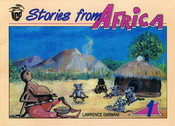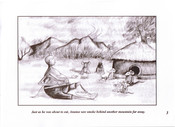Darmani, Lawrence Stories from AfricaVol. 1
Artwork by Skills Graphix. Achimota, Ghana: Africa Christian Press, 1994. 34 p. ISBN 9964-87-852-4. Ages 8–10.
Summary
This is the first book in a two-part series on popular folktales from different parts of Africa. Each book is a collection of five short folktales that illustrate either a moral or a lesson. In “Ananse Looks for Food,” greedy Ananse embarks on a journey because he feels that the food in his village is not tasty enough for him. After going to Plantain, Sweet Potato, and Cassava villages, he ends up hungry and tired in his own Meat Village – and realises that the food of his village is the best. In “Dupe and Kupe,” the story of two mischievous monkeys who like to play tricks, Kupe’s inordinate greed and lack of caution while stealing food leads to his death. “Agya Nimo the Rich Man” will teach young readers that one should develop a sense of community by helping one’s neighbours. Agya Nimo learns this lesson when his wife dies and the villagers do not come to help but send gifts instead. Then Agya Nimo remembers the proverb, “The left hand washes the right hand and the right hand washes the left hand” (19–20). In “The Stolen Goat,” a thief is tricked when he tries to sell the goat he has stolen. The last story, “The Treasure,” is the popular folktale of a father who, before dying, tells his sons that their inheritance is buried in his land. While digging for the treasure, the sons clear the weeds, plough the fields, plant seeds, and eventually harvest the crops. In the end they realise that the “treasure” is the lesson that hard work is rewarding.
Commentary
These folktales are retold in a fast-moving narrative style that is interspersed with plenty of dialogue to hold the interest of readers (or listeners). The lessons on leading a harmonious, productive, and contented life are illustrated through the stories of both animals and humans. Each folktale has a simple plot and sparse character development, and the accompanying black-and-white illustration captures its most significant or dramatic moment. This book has been translated into two Ghanaian languages, Daagare and Asante Twi.
Folk Tales Ghana Africa Christian Press (ACP) | |   |



